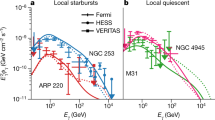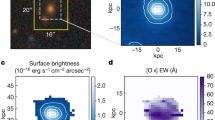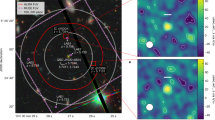Abstract
The Milky Way galaxy is surrounded by a circumgalactic medium1 that may play a key role in galaxy evolution as the source of gas for star formation and a repository of metals and energy produced by star formation and nuclear activity2. The circumgalactic medium may also be a repository for baryons seen in the early universe, but undetected locally3. The circumgalactic medium has an ionized component at temperatures near 2 × 106 K studied primarily in the soft-X-ray band4,5. Here we report a survey of the southern Galactic sky with a soft-X-ray spectrometer optimized to study diffuse soft-X-ray emission6. The X-ray emission is best fitted with a disk-like model based on the radial profile of the surface density of molecular hydrogen, a tracer of star formation, suggesting that the X-ray emission is predominantly from hot plasma produced via stellar feedback. Strong variations in the X-ray emission on angular scales of ~10° indicate that the circumgalactic medium is clumpy. Addition of an extended, and possibly massive, halo component is needed to match the halo density inferred from other observations7,8,9.
This is a preview of subscription content, access via your institution
Access options
Access Nature and 54 other Nature Portfolio journals
Get Nature+, our best-value online-access subscription
$29.99 / 30 days
cancel any time
Subscribe to this journal
Receive 12 digital issues and online access to articles
$119.00 per year
only $9.92 per issue
Buy this article
- Purchase on Springer Link
- Instant access to full article PDF
Prices may be subject to local taxes which are calculated during checkout




Similar content being viewed by others
Data availability
The OMNI data are available at https://omniweb.gsfc.nasa.gov/ and the ACE data at http://www.srl.caltech.edu/ACE/ASC/level2/lvl2DATA_SWICS_SWIMS.html. The first year of HaloSat data are available at NASA’s HEASARC. The additional HaloSat data analysed in this study are available on request to P.K. The spectral fitting results will be made available for download at the CDS and on request to P.K.
Code availability
The computer codes used to analyse the data in this study are available from the corresponding author on request.
References
Tumlinson, J., Peeples, M. S. & Werk, J. The circumgalactic medium. Annu. Rev. Astron. Astrophys. 55, 389–432 (2017).
Putman, M. E., Peek, J. E. G. & Joung, M. R. Gaseous galaxy halos. Annu. Rev. Astron. Astrophys. 50, 491–529 (2012).
Shull, J. M., Smith, B. D. & Danforth, C. W. The baryon census in a multiphase intergalactic medium: 30% of the baryons may still be missing. Astrophys. J. 759, 23 (2012).
McCammon, D. et al. A high spectral resolution observation of the soft X-ray diffuse background with thermal detectors. Astrophys. J. 576, 188–203 (2002).
Miller, M. J. & Bregman, J. N. The structure of the Milky Way’s hot gas halo. Astrophys. J. 770, 118 (2013).
Kaaret, P. et al. HaloSat: a CubeSat to study the hot Galactic halo. Astrophys. J. 884, 162 (2019).
Weiner, B. J. & Williams, T. B. Detection of Hα emission from the Magellanic Stream: evidence for an extended gaseous galactic halo. Astron. J. 111, 1156–1163 (1996).
Grcevich, J. & Putman, M. E. Hi in local group dwarf galaxies and stripping by the Galactic halo. Astrophys. J. 696, 385–395 (2009).
Gupta, A., Mathur, S., Krongold, Y., Nicastro, F. & Galeazzi, M. A huge reservoir of ionized gas around the Milky Way: accounting for the missing mass? Astrophys. J. 756, L8 (2012).
Koutroumpa, D., Acero, F., Lallement, R., Ballet, J. & Kharchenko, V. OVII and OVIII line emission in the diffuse soft X-ray background: heliospheric and galactic contributions. Astron. Astrophys. 475, 901–914 (2007).
Liu, W. et al. The structure of the Local Hot Bubble. Astrophys. J. 834, 33 (2017).
Cappelluti, N. et al. The Chandra COSMOS legacy survey: energy spectrum of the cosmic X-ray background and constraints on undetected populations. Astrophys. J. 837, 19 (2017).
Miller, M. J. & Bregman, J. N. Constraining the Milky Way’s hot gas halo with O vii and O viii emission lines. Astrophys. J. 800, 14 (2015).
Zhu, H., Tian, W., Li, A. & Zhang, M. The gas-to-extinction ratio and the gas distribution in the galaxy. Mon. Not. R. Astron. Soc. 471, 3494–3528 (2017).
Snowden, S. L., Burrows, D. N., Sanders, W. T., Aschenbach, B. & Pfeffermann, E. ROSAT observations of the Eridanus soft X-ray enhancement. Astrophys. J. 439, 399–404 (1995).
Nakashima, S. et al. Spatial distribution of the Milky Way hot gaseous halo constrained by Suzaku X-ray observations. Astrophys. J. 862, 34 (2018).
Henley, D. B. & Shelton, R. L. An XMM-Newton survey of the soft X-ray background. III. The galactic halo X-ray emission. Astrophys. J. 773, 92 (2013).
Henley, D. B. & Shelton, R. L. An XMM-Newton survey of the soft X-ray background. II. An all-sky catalog of diffuse O vii and O viii emission intensities. Astrophys. J. Suppl. Ser. 202, 14 (2012).
Kuntz, K. D. Solar wind charge exchange: an astrophysical nuisance. Astron. Astrophys. Rev. 27, 1 (2019).
Savage, B. D. & Wakker, B. P. The extension of the transition temperature plasma into the lower galactic halo. Astrophys. J. 702, 1472–1489 (2009).
Norman, C. A. & Ikeuchi, S. The disk–halo interaction: superbubbles and the structure of the interstellar medium. Astrophys. J. 345, 372–383 (1989).
Schmidt, M. The rate of star formation. Astrophys. J. 129, 129–243 (1959).
Nakanishi, H. & Sofue, Y. Three-dimensional distribution of the ISM in the Milky Way galaxy: II. The molecular gas disk. Publ. Astron. Soc. Jpn 58, 847–860 (2006).
Salem, M. et al. Ram pressure stripping of the Large Magellanic Cloud’s disk as a probe of the Milky Way’s circumgalactic medium. Astrophys. J. 815, 77 (2015).
Maller, A. H. & Bullock, J. S. Multiphase galaxy formation: high-velocity clouds and the missing baryon problem. Mon. Not. R. Astron. Soc. 355, 694–712 (2004).
Fang, T., Bullock, J. & Boylan-Kolchin, M. On the hot gas content of the Milky Way halo. Astrophys. J. 762, 20 (2013).
Rachford, B. L. et al. A Far Ultraviolet Spectroscopic Explorer survey of interstellar molecular hydrogen in translucent clouds. Astrophys. J. 577, 221–244 (2002).
Hodges-Kluck, E. J., Miller, M. J. & Bregman, J. N. The rotation of the hot gas around the Milky Way. Astrophys. J. 822, 21 (2016).
Hill, A. S. et al. Vertical structure of a supernova-driven turbulent, magnetized interstellar medium. Astrophys. J. 750, 104 (2012).
LaRocca, D. M. et al. Design and construction of the x-ray instrumentation onboard the HaloSat CubeSat. J. Astron. Telesc. Instrum. Syst. 6, 014003 (2020).
Arnaud, K. A. XSPEC: the first ten years. In ASP Conference 101, Astronomical Data Analysis Software and Systems V (eds Jacoby, G. H. & Barnes, J.) 17–20 (ASP, 1996).
Zajczyk, A. et al. HaloSat: a search for missing baryons with a CubeSat. In Proc. 32nd Annual AIAA/USU Conference on Small Satellites SSC18-WKIX-01 (2018); https://go.nature.com/3iwyu9H
Smith, R. K., Brickhouse, N. S., Liedahl, D. A. & Raymond, J. C. Collisional plasma models with APEC/APED: emission-line diagnostics of hydrogen-like and helium-like ions. Astrophys. J. Lett. 556, L91–L95 (2001).
Wilms, J., Allen, A. & McCray, R. On the absorption of X-rays in the interstellar medium. Astrophys. J. 542, 914–924 (2000).
Verner, D. A., Ferland, G. J., Korista, K. T. & Yakovlev, D. G. Atomic data for astrophysics. II. New analytic fits for photoionization cross sections of atoms and ions. Astrophys. J. 465, 487–498 (1996).
Planck Collaboration et al. Planck 2013 results. XI. All-sky model of thermal dust emission. Astron. Astrophys. 571, A11 (2014).
Green, G. M. dustmaps: a Python interface for maps of interstellar dust. J. Open Source Softw. 3, 695 (2018).
Cox, D. P. in The Local Bubble and Beyond: Lyman-Spitzer-Colloquium (eds Breitschwerdt, D. et al.) 121–131 (Springer, 1998).
Koutroumpa, D., Acero, F., Lallement, R., Ballet, J. & Kharchenko, V. O vii and O viii line emission in the diffuse soft X-ray background: heliospheric and galactic contributions. Astron. Astrophys. 475, 901–914 (2007).
Koutroumpa, D. et al. Charge-transfer induced EUV and soft X-ray emissions in the heliosphere. Astron. Astrophys. 460, 289–300 (2006).
Lallement, R., Bertaux, J. L., Kurt, V. G. & Mironova, E. N. Observed perturbations of the velocity distribution of interstellar hydrogen atoms in the solar system with Prognoz Lyman-alpha measurements. Astron. Astrophys. 140, 243–250 (1984).
Dalaudier, F., Bertaux, J. L., Kurt, V. G. & Mironova, E. N. Characteristics of interstellar helium observed with Prognoz 6 58.4-nm photometers. Astron. Astrophys. 134, 171–184 (1984).
Gloeckler, G. et al. Investigation of the composition of solar and interstellar matter using solar wind and pickup ion measurements with SWICS and SWIMS on the ACE spacecraft. Space Sci. Rev. 86, 497–539 (1998).
Koutroumpa, D., Quémerais, E., Ferron, S. & Schmidt, W. Global distribution of the solar wind flux and velocity from SOHO/SWAN during SC-23 and SC-24. Geophys. Res. Lett. 46, 4114–4121 (2019).
Savage, B. D., Edgar, R. J. & Diplas, A. The distribution of interstellar Al iii away from the galactic plane. Astrophys. J. 361, 107–115 (1990).
Qu, Z. & Bregman, J. N. The warm gaseous disk and the anisotropic circumgalactic medium of the Milky Way. Astrophys. J. 880, 89 (2019).
Ivezi, E., Connolly, A. J., VanderPlas, J. T. & Gray, A. Statistics, Data Mining, and Machine Learning in Astronomy: A Practical Python Guide for the Analysis of Survey Data (Princeton University Press, 2014).
Acknowledgements
We acknowledge support from NASA grant NNX15AU57G and the Iowa Space Grant consortium. D.K.’s modelling work was supported by CNES and performed with the High Performance Computer and Visualisation (HPCaVe) platform hosted by UPMC-Sorbonne Université. We thank J. Raines and the SWICS team for providing the solar-wind data.
Author information
Authors and Affiliations
Contributions
P.K. carried out the X-ray data analysis and wrote the text; D.K. carried out the heliospheric SWCX modelling; D.M.L. wrote the code to calculate the absorption column densities and the LHB emission measures; D.K., K.D.K., E.H.-K., K.J., D.M.L., A.Z., R.R., J.B. and H.G. read and commented on the manuscript.
Corresponding author
Ethics declarations
Competing interests
The authors declare no competing interests.
Additional information
Peer review information Nature Astronomy thanks Randall Smith and the other, anonymous, reviewer(s) for their contribution to the peer review of this work.
Publisher’s note Springer Nature remains neutral with regard to jurisdictional claims in published maps and institutional affiliations.
Extended data
Extended Data Fig. 1 HaloSat X-ray spectra.
X-ray spectra of the HaloSat field at (l = 122.616∘, b = − 55.418∘). Data from the three detectors are shown, detector 14 in black, 54 in orange, and 38 in blue. Errors indicate 1-σ confidence intervals. The average exposure per detector is 28 ks. The best fitted model and the powerlaw used to model the instrumental background is shown in the same colour for each detector. The model components are shown as black lines. At 0.6 keV, the highest is the sum of the astrophysical components (all components except the instrumental background), the thermal plasma for the halo, the instrumental background, the cosmic X-ray background, the Ovii oxygen line, the thermal plasma for local hot bubble, and the Oviii oxygen line.
Extended Data Fig. 2 HaloSat instrumental background model.
The photon index of the instrumental background for each detector is calculated from the count rate in the 3-7 keV band using the slope and intercept values in the table in the equation: Photon index = slope × (hard rate - hr0) + intercept, where hr0 = 0.05 c/s.
Extended Data Fig. 3 Heliospheric Solar wind charge exchange.
Illustration of the sum used to calculate the line flux due to heliospheric solar wind charge exchange (SWCX) along a line of sight. The Sun is at the origin and the figure is limited to the first 2 AU. Ecliptic longitude is zero along the horizontal axis to the right and increases anti-clockwise. Each triangle represents a term in the sum at the radial distance form the Sun (Dj) with the solar wind intensity evaluated for the time of flight Tj from a radius of 1 AU. The inset shows the H and He neutral densities scaled by the step size (ds) and by \({(1{\rm{AU}}/{D}_{j})}^{2}\) as a function of radial distance from the Sun for the full radial scale of the simulations. The density profiles were calculated for the Earth at 126.56∘ ecliptic longitude and a look direction of (λ = 39.88∘, β = − 7.64∘) that crosses the He-focusing cone and the H-ionization cavity resulting in a high oxygen line flux and a high He/H neutral density ratio.
Extended Data Fig. 4 Density Model Fit Results.
Results of fitting the EM data to various density profiles. The first column specifies the model, model parameters, and goodness of fit statistics. Results from fitting using a patchiness parameter are given in the second column and using a Huber loss function in the third column. The Fit statistic is either χ2 with the patchiness parameter included or the value of the Huber loss function.
Rights and permissions
About this article
Cite this article
Kaaret, P., Koutroumpa, D., Kuntz, K.D. et al. A disk-dominated and clumpy circumgalactic medium of the Milky Way seen in X-ray emission. Nat Astron 4, 1072–1077 (2020). https://doi.org/10.1038/s41550-020-01215-w
Received:
Accepted:
Published:
Issue Date:
DOI: https://doi.org/10.1038/s41550-020-01215-w



